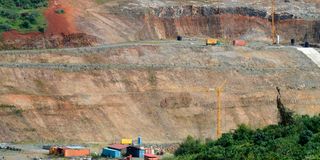Itare biggest beneficiary of Sh50bn new budget allocation for dams

A section of the stalled Itare dam in Kuresoi North, Nakuru County, on October 8, 2020.
President William Ruto plans to spend close to Sh50 billion on construction of dams over the next three years, with heavy spending on several that were started years ago as some that stalled on the way miss out.
The 2023/24 budget estimates show that among dams not currently featured are Arror and Kimwarer, which stalled years ago following corruption allegations. Others such as Itare, which had equally stalled after having been under construction for many years, have been allocated funds.
In the financial year starting July 2023, the government, through the state departments of Irrigation, and Water and Sanitation, plans to spend about Sh14 billion on construction of at least 22 dams.
About 78 per cent of the money, Sh10.79 billion, will be channelled into three dams—Mwache in Kwale County (Sh5.4 billion), Thwake at the border of Makueni and Kitui counties (Sh3.36 billion) and Thiba in Kirinyaga County (Sh2 billion).
Over the three years through to June 2026, the Ruto administration plans to put Sh26.8 billion in the three dams, out of the Sh46 billion total spending on the 22 dams.
Between July 2023 and June 2026, which will make three of President Ruto’s first five-year term in office, Mwache dam will be his greatest focus, with a budget of Sh16.3 billion lined up for the project.
At least Sh5.56 billion has been budgeted for Thwake dam Phase 1 over the three years, with Sh3.36 billion being pumped in during the year starting July.
Itare dam, a Sh38 billion mega project in Nakuru that has been in limbo since 2019 after it was rocked by corruption allegations and the subsequent financial troubles that faced the contractor CMC di Ravena, has been allocated at least Sh1.2 billion over the three years. After his election in August last year, President Ruto indicated that the dam was among his top priorities.
“My number one priority, once I’m sworn in, will be to restart construction of the dam and ensure its timely completion,” he said in Nakuru.
Chemususu Dam, which has also been an ongoing project since 2009, has been allocated Sh772 million over the next two financial years. The project was commissioned by former President Uhuru Kenyatta in 2017.
Other dams that had also stalled but have received allocations to proceed with construction include Badasa dam in Marsabit County and Umaa dam in Kitui County.
In November last year, Water Cabinet Secretary Alice Wahome indicated that the government planned to build at least 100 dams under the public-private partnerships (PPPs), with private firms constructing the dams and then recovering their money through water tariffs.
“Don’t get worried about the issue of the water being expensive because there is also a regulative body that will deal with tariffs. We cannot worry about the cost of a commodity that we don’t have. We must first develop the commodity, develop the water resources, have it, and then discuss how much we shall sell it,” Ms Wahome said.
This is the same model under which the Sh425 billion Grand High Falls Dam, to be constructed under a partnership between Kenya and the United Kingdom, will be delivered, the UK government stated last year.
“A water purchase agreement is a new structure that the government is keen to pioneer in Kenya, under which the dam project will provide irrigation water for farmland, and use the fees for irrigation to repay the privately raised funds to finance the construction of the dam,” the UK High Commission in Nairobi said.





